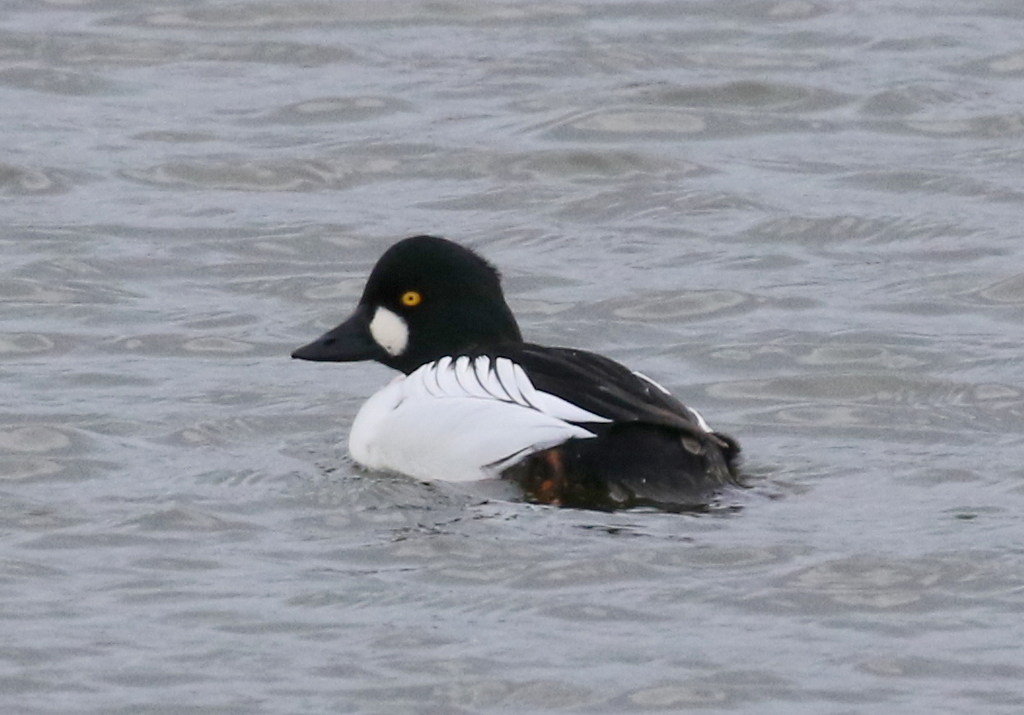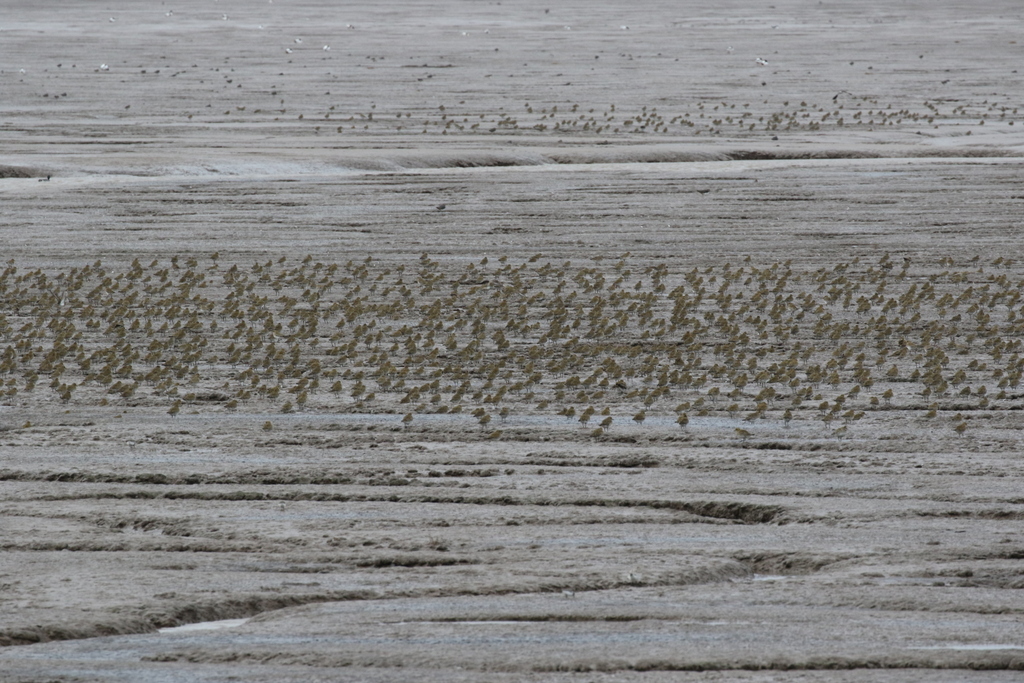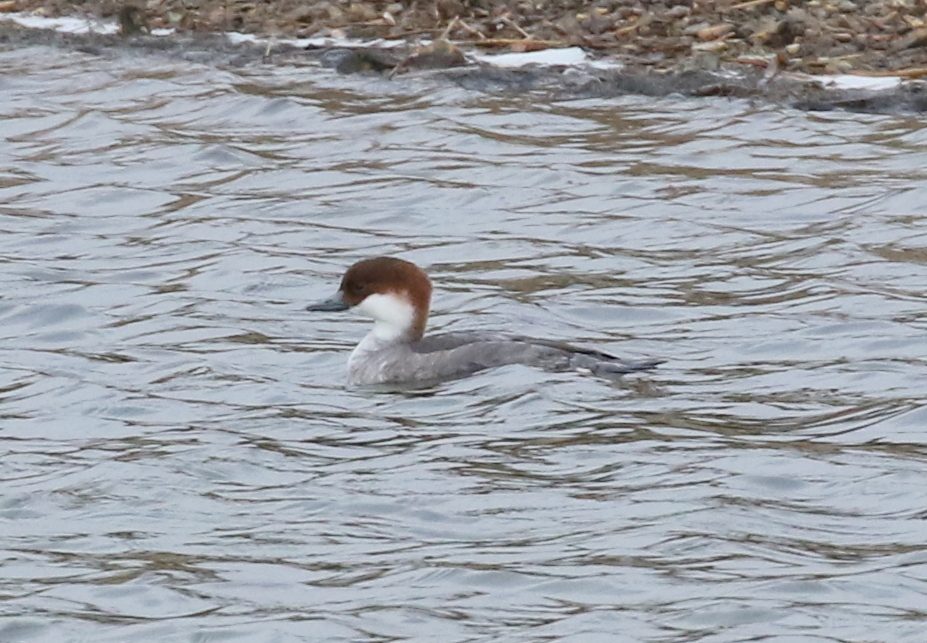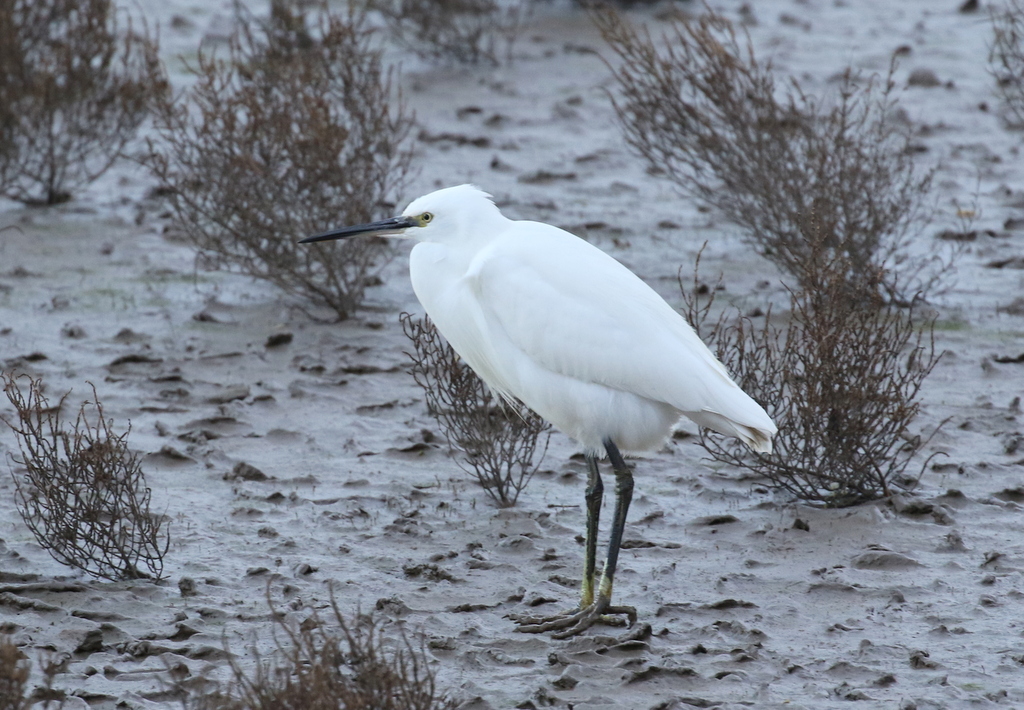Day 3 of a three day Winter Tour today, our last day. Having explored the North Norfolk coast to the east yesterday, we were heading west today. It was a very windy day today, and mostly cloudy although we thankfully managed to almost all of the showers.
We made a quick visit to Wells Harbour first thing. There has been a Glaucous Gull around the Wells / Holkham area the last few days and, although the seal pup carcass it had been feeding on is now all gone, we thought there was an outside chance it might be roosting with the other gulls in the harbour still. Unfortunately, there was no sign of the Glaucous Gull, but we did see a Guillemot diving among the boats in the outer dock, along with a couple of Little Grebes.
We had a quick look out on the sandbanks in the harbour, and could see a good number of waders feeding out there. They were mostly Oystercatchers, but we found a few Curlews and a single Bar-tailed Godwit feeding along the edge of the channel and two more distant Grey Plovers, up on the mudflats beyond.
A pair of Red-breasted Mergansers were diving on the far side of the channel, moving quickly with the tide but hard to see in the choppy water. When they got to the tip of the sandspit, they hauled themselves out onto the point where they were a bit easier to see. Another pair of Red-breasted Mergansers swam across the channel much further out.

As we carried on our way west, we turned inland and had a quick drive round some of the minor roads through Choseley. There had been a Rough-legged Buzzard seen here a couple of times over the last few days, but there was no obvious sign of it where it had been.
The hedges along the roadsides were rather quiet today. We found a small flock of Chaffinches and Goldfinches, and four Skylarks fluttering up over a grassy meadow by the road. A cover strip planted by a thick hedge held lots of Reed Buntings and a couple of Yellowhammers, which were nice to see, but even here there were not as many birds as usual. Perhaps it was due to the wind? A Fieldfare in the top of a tree across the road was calling.
Our first destination proper for the morning was Snettisham. As we made our way down towards the Wash, we stopped to look at a smart drake Goldeneye on one of the gravel pits – the first of many we would see here! Three Tufted Ducks were on the pits too, an addition to the weekend’s list.

Up on the seawall, it was just a little before high tide but it was not going to be a big tide today so a large expanse of mud would remain uncovered. Several thousand Golden Plover were gathered in a huge flock on the mud, and a big black smear on the beach to the north was a large roosting flock of Oystercatchers. When we turned the scope to look towards them, we could see a small group of eight Pintail on the edge of the water too.

There were more waders down along the edge of the channel below us. Here we could see several Knot, Bar-tailed Godwit and Dunlin. We were just having a closer look at them in the scope when suddenly everything spooked. The waders all took off and the huge flock of Golden Plover whirled round in the sky out over the mud. A Sparrowhawk flew in over the seawall, and disappeared off inland – that was why! A Red Kite drifted south just inland of the Pits too, but didn’t cause the same sort of commotion.

Continuing on down towards Rotary hide, we could see the Smew on the pit north of the causeway with a small group of Goldeneye. It was diving periodically, but helpfully also staying up for long periods today so we could get a really good look at it through the scope. It is a ‘redhead’, a term which includes both adult female Smew and first winter birds which are rather similar. We could see its rusty cap and white cheeks.

The Goldeneye were mostly drakes, with one female. The female appeared to be paired up already and when one of the other drakes started displaying, swimming around with its head up, the drake from the pair swam after it, with its head held down close to the water, neck outstretched. There were lots of other birds on the pits. Lots of Wigeon and Greylag Geese, together with smaller numbers of Shoveler. A couple of Little Grebes were busily diving here too.
We had a walk round to look for the Short-eared Owl which normally roosts here, but strangely there was no sign of it in its usual spot today. There is lots of disturbance at the south end of the Pit at the moment, as contractors have begun work on the foundations of the new hide, so perhaps all the commotion has disturbed the owl. It began to drizzle very lightly at this point, so with all the disturbance we decided against walking all the way round the Pit and headed back to the car. Thankfully the drizzle quickly cleared.
Our next stop was at Thornham Harbour. It was very exposed out on the open saltmarsh in the wind. Several people with binoculars and cameras were milling around in the car park. The tide was still high in the harbour channel, but there was a bit of exposed mud by the sluice, where a couple of Redshank and a Curlew were feeding. We managed to get a good look at a Black-tailed Godwit feeding down on the mud here too.
We were about to walk up onto the seawall when we noticed some movement down in the vegetation on the edge of the saltmarsh below. We looked down to see a Goldfinch and a Twite feeding together. The more we looked, the more Twite we could see, but they were perfectly camouflaged and mostly hidden in the dead vegetation.
With a bit of patience, one or two of the Twite emerged to feed on some stems where we could see them, and we got a good look at them through the scope. We could see their orange breasts and distinctive yellow bills. Three of the flock were colour-ringed – showing these are birds which breed in the Pennines and come here for the winter.
Suddenly for no reason the Twite flew up and out across the harbour. Now we could see there were 14 of them in total. They circled round and landed on the roof of the old coal barn, where we could just see them through the scope on the tiles. Then after a few minutes they came back again, flying round in front of us, before they landed on the top of some seedheads right by the path just below us. Great views! Then they flew back down to where they had been feeding before, below the bank out of the wind, and mostly disappeared again.

It was time for lunch now, so we made our way round to Titchwell. A Robin was perched in the tree by the car as we got out, and as we looked over at it one of the group spotted something look out round the back of one of the trees beyond. It was a Woodcock, but unfortunately it immediately disappeared back behind the tree before anyone else could see it and despite looking from various angles it didn’t reappear.
We made good use of the picnic tables by the Visitor Centre for lunch. There were lots of birds on the feeders – Chaffinches, Goldfinches and Greenfinches, plus a few tits too – Blue and Great Tit, Coal Tit and Long-tailed Tit. A Brambling appeared briefly on the ground with the Chaffinches, but unfortunately it was behind a tree from where we were sitting and flew back into cover. Thankfully it reappeared after a couple of minutes and we had good views of it, on the ground, in the bushes, and then up onto one of the feeders. Bramblings have been rather scarce here so far this winter, so this was a good one to see.

After lunch, we headed out onto the reserve. Scanning the ditch by the path as we went, we quickly located a Water Rail. It was well hidden under a tangle of branches at first, though the ripples in the water gave its location away. Eventually it came out more into the open where we could get a really good look at it. A few metres further on, we then spotted another Water Rail in the ditch on the other side of the path – two for the price of one!

We had a quick look on Thornham grazing marsh where the drained pool is now getting very overgrown. We could hear Bearded Tits ‘pinging’ from the reeds but they were keeping tucked well down out of the wind today – not an ideal day to look for them! Four Marsh Harriers were already hanging in the air over the reedbed the other side – at least they appeared to be enjoying the wind. A large flock of Brent Geese flew in chattering, and landed on Freshmarsh.
The water level on the Freshmarsh is high for the winter at the moment. There were a few ducks on here – mostly Teal, plus a few Shoveler and Shelduck – but otherwise it looked fairly empty. A handful of Lapwings were roosting on the one remaining small island close to the path.
We made our way round to Parrinder Hide, where we could get out of the wind. Looking into the larger fenced-off island, we eventually found the Water Pipit. It was tricky to see, feeding down in the cut vegetation, but eventually we all got a good look at it. Two Skylarks were creeping around on there too. And there were several Golden Plover and a few Wigeon on the island as well.
On our way out to the beach, we had a quick look over the wall where a Grey Plover was feeding on Volunteer Marsh the other side. There were more waders along the channel at the far side, looking out from the main path – Black-tailed Godwits, Curlews, Redshanks and several more Grey Plover. We got one in Grey Plover in the scope for a closer look. A Little Egret was feeding down in the muddy channel too.

There didn’t seem to be much on the no-longer-tidal ‘Tidal Pools’ – they are very full of water at the moment after recent big tides, and the water doesn’t drain off any more. There were a few more ducks on here, including four Pintails. We watched one pair feeding out on the water, upending, the drake showing off his long tail.
Out at the beach, the tide was still just going out. The first thing we saw was two female Common Eider on the beach, shortly after joined by a third which flew in and landed with them. The mussel beds were still covered by the sea, but there were plenty of Oystercatchers, Bar-tailed Godwits and Sanderling down on the sand. More Bar-tailed Godwits were flying in, presumably coming out of their roost sites on the falling tide, and a flock of Knot flew past just offshore.
There was not much out on the sea this afternoon. Scanning over the water, we found a single Common Scoter and a pair of Red-breasted Merganser. When a squall appeared out over the mouth of the Wash, we could just see one or two Little Gulls way out on the front edge of it. As the squall passed over the sea, three Little Gulls came past much closer. As they dipped down to the water, we could see the black underwings of the adults.
The light was starting to go now, so we made our way back to the Freshmarsh. We were planning to watch all the birds coming in to roost here this evening. As we stood on the bank, we could already see lots of Marsh Harriers whirling around over the reedbed. More and more came up into the air, until we counted over 40 in the sky together, quite an impressive sight!
There were a few gulls in already, bobbing on the water, but none seemed to be coming in from the fields yet, waiting perhaps due to the wind. An Avocet had now appeared on the small island close to the path, sheltering behind the far edge with the gulls. The wind seemed to pick up again now and we looked round behind us to see a patch of threatening cloud coming in from west, so we retreated to the shelter of Parrinder Hide again.
We continued to watch the Marsh Harriers from the hide, and after a while a ringtail Hen Harrier appeared in with them. It whisked through very quickly though, away over the bank towards Brancaster. We waited to see if it would return and then two ringtail Hen Harriers appeared again, in with the Marsh Harriers. All the birds were very active, flying back and forth over the reeds, in and out of the bushes, occasionally breaking the skyline. The light was really going now, but we could see the pale underside of the Hen Harriers flashing as they turned, and the distinctive white square at the base of their tail on the upperside.
The trees behind the harriers were filling up with Little Egrets, coming in to roost too. As it started to get dark, the gulls finally started to fly in from the fields, but it was getting too dark to see clearly now. It was time to head for us to head for home.
















